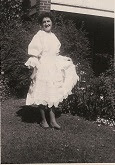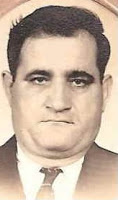Originally published on genealogyatheart.blogspot.com on 8 Jul 2015.
Every little girl wants to be a princess and I was no different. My grandmother, Mary Violet Koss, loved to tell the story of how the family was awarded a title of PL by royalty back in the day. The details were sketchy of when the event occurred but the story and the privileges that were a result were a well remembered family legend.
Marauding bands of Turks had been seen throughout the land for some time. As peasant farmers, my family and others like them, were often the first to warn the community of the approaching men on horseback. With a shout in the fields, tools were flung aside and a fast run to the castle for safety ensued. One day, however, not just a few men on horseback appeared but an entire army. Fighting from the castle became intense and many men had perished on both sides. It appeared that the castle would soon be overtaken and in despair, the women, among them my many times great grandmother, decided to take action. Using the communal cooking pots, when a rolling boil was reached the vats’ contents of oil or water was poured down upon the enemy. The fight was soon over as the invaders fled in retreat.
For valor, my grandmother’s husband was awarded the title of PL, an abbreviation of the word plemeniti which is Croatian for “noble.” This permitted the family to have special privileges, such as hunting in the king’s forest, a lessening of the annual taxed amount and a voice in community affairs.
When did this occur? Who was the King that granted the title? Where was the castle located? How can I verify that my family really was awarded this honor? Non did not know but she knew that her father, Joseph Kos, was the last of the line to be able to reap the benefits of the title. Joseph had been a leader in the Austria-Hungary Calvary when Non was a child and his position afforded the family a comfortable life. Unfortunately, while holding his horse that was being re-shoed, the horse kicked Joseph in the chest which caused him to become an asthmatic. He was released from his duties and with no prospects for another career, emigrated in 1910 to America.
As an adult, I wanted to dig further into the family lore and discover what event led to the title. The only additional information I could recall was that as a practicing Roman Catholic, Non had said the Turks not only wanted more land but wanted to put an end to Catholicism. Using religion as my first clue I began to investigate when the region became Catholic.
Although there is not agreement on when Croatia became Christianized, it most likely was over several centuries beginning in the 7th with the faith becoming firmly established by 925 when the ruler Tomislav aligned himself with Pope John X.1 Most of the titles Tomislav extended were to noncitizens so it is not probable that the PL title was conferred to my relatives by Tomislav.
Next I decided to research when the Ottoman invasion occurred. After Coloman united Austria and Croatia in 1102 2, the Ottoman’s began to invade the area. History records that the Great Turkish War occurred between 1667-1698. I suspect, if the PL designation occurred, it would have been between 1102 and 1698.
My family resided close to the present city of Zagreb; both of my grandparents being born in the tiny village of Dubranec. In 1900, they were 2 of the 454 residents.3 Today, Dubranec is part of the city of Velika Gorica so I investigated battles that occurred nearby. “In 1278 noblemen from Turopolje joined into a union called Plemenita opčina turopoljska (“Noble municipality of Turopolje”). Plemenita opčina turopoljska was granted a rule over Turopolje by Croatian monarchs and exists still today with mainly (a) ceremonial and not political role. Regarding the Turopolje name, among the most common opinions is that the name, meaning “Tur field”, comes from an old Slavic word “tur” which means Aurochs, an ancient type of cattle with long horns, which was a symbol of fertility and the sun god. These cattle died out in the 16th century. The cattle were closely related to agriculture. Plowing had a symbolic meaning, the fertilization of Mother Earth, so these cattle were often assumed to have “sacred” characteristics. Because of its importance in the life of the plowmen, “tur” became the basis for numerous toponyms. However, as recently as the 16th century, Turopolje was called Campus Zagrebiensis, i.e. “Zagreb field”, or just Campus (field). At that time the name was replaced by “Tur field”, i.e. Turopolje”.4 Knowing my family were farmers this most likely was the event my Non described.
Investigating further, I found it was King Ladislas IV of Hungary and Croatia who confirmed “the ‘nobles of Turopolje’. (They) originally were (but with no doubt at the time when their charter was issued in 1278, castle-warriors of Zagreb (iobagiones castri Zagra-biensis), i.e. they occupied – because of their military duties – the most honourable rank within the population of the castle, but they were definitely subjugated to the jurisdiction held by the comes of Zagreb.”5 I cannot find reference to an Ottoman invasion of Zagreb during this time, however, Osman I, who was the individual the Ottoman/Turkish empire was named for, did begin to expand settlements into the eastern Mediterranean and Balkans during this time.6
Interestingly, King Ladislas IV was more of a Pagan than a Roman Catholic so he may have more in common with the tur plowmen’s sun god and Mother Earth worship than just military exploits.
The only part of the story left to verify is whether my Kos line was one of the Turopoljes. I was able to find that in the Armorial Book, Duis Dragon Hung, Kos was a name that was granted nobility status.7 That doesn’t necessarily mean that it was my line, however. Alas, even if I can confirm
1 Vladimir Posavec (March 1998).”Historical Maps and Borders in the Age of Tomislav. Radovi Zavoda za hrvatsku povijest (in Croatian) 30 (1): 281–290. ISSN 0353-295X. Retrieved 28 Jun 2015.
2 Ladislav Heka (October 2008). Croatian-Hungarian relations from the Middle Ages to the Compromise of 1868, with a special survey of the Slavonian issue. Scrinia Slavonica (in Croatian) (Hrvatski institut za povijest – Podružnica za povijest Slavonije, Srijema i Baranje) 8 (1): 152–173.ISSN 1332-4853 Retrieved 28 Jun 2015.
3“Google Translate.” Google Translate. N.p.,Web. 29 June 2015.
4“Velika Gorica.” Velika Gorica. N.p., Web. 29 June 2015.
5“Noble Communities in Spiš and Turopolje in the Thirteenth and Fourteenth Centuries.” Noble Communities in Spiš and Turopolje in the Thirteenth and Fourteenth Centuries. p.224., n.d. Web. 29 June 2015
6 The Sultans: Osman Gazi. The Ottomans.org. Retrieved 13 December 2010.
7“Google Translate.” Google Translate. N.p., Web. 29 June 2015.








